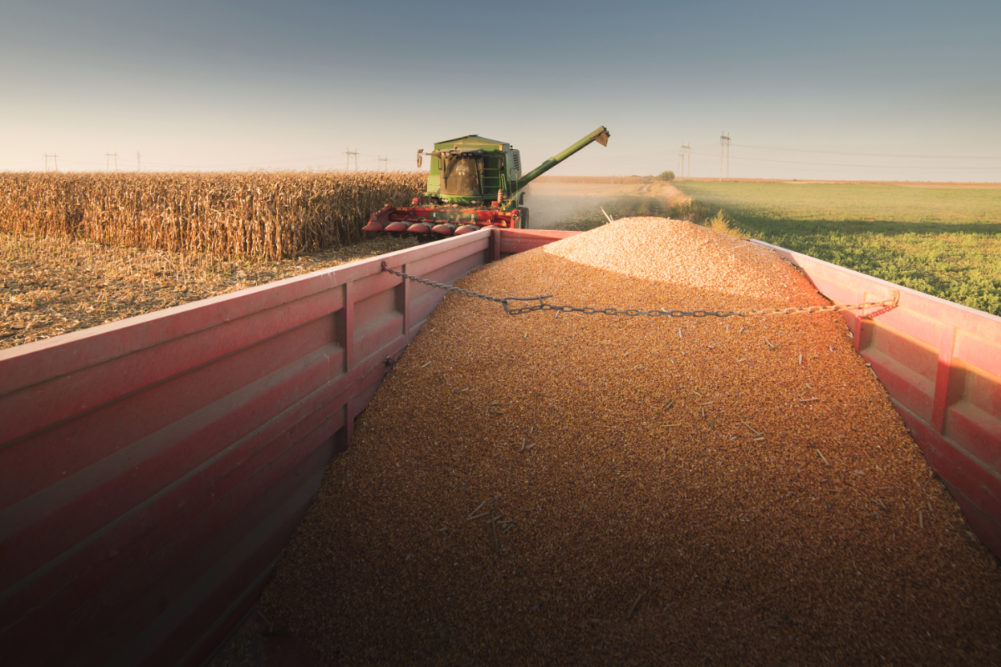WASHINGTON — As the harvests of smaller-than-expected but still large US 2020 soybean and corn crops neared completion last week, prices hovered at multi-year highs after the US Department of Agriculture on Nov. 10 cut production and carryover forecasts for both crops.
The USDA estimated 2020 US soybean production at 4,170 million bus, down 2.3% from its October forecast but up 17% from 2019 and the fourth largest crop on record if realized. Soybean carryover on Sept. 1, 2021, was forecast at 190 million bus, down 34% from October and down 64% from 2020.
Corn production in 2020 was estimated at 14,507 million bus, down 1.5% from the October forecast but up 7% from last year and still the third largest crop on record. Corn carryover on Sept. 1, 2021, was forecast at 1,702 million bus, down 21% from October and down 15% from 2020.
The USDA corn and soybean production and carryover forecasts all were below the average of pre-report trade expectations.
Since Nov. 9, the close prior to the key USDA reports, nearby soybean futures were up about 60¢ a bu, or 5%, and at four-year highs. Nearby corn futures were up about 12¢ a bu, or 3%, and near 15-month highs early last week. Nearby soybean futures were up more than 25% from a year ago, while corn futures were up more than 10%.
“Soybeans are in the driver’s seat right now,” said Paul Meyers, vice president of commodity analysts, Foresight Commodity Services, Inc., noting that the projected 2021 soybean ending stocks-to-use ratio at 4.2% is the second lowest on record after 2.6% in 2014, with the possibility of going lower.
Soybean prices have been supported by ongoing strong domestic demand, large export sales to China and declining crop prospects in South America, with Brazil the leading US competitor in the export market.
The National Oilseed Processors Association last week said October soybean crush was 185,245,000 bus, a record high for any month and above all trade expectations.
China has been an active buyer of US soybeans (as well as corn) throughout the spring and summer, although sales have slowed in the past few weeks. Demand for soybean meal as a source of protein as well as for corn is soaring as China rapidly rebuilds its hog herd, which was devastated by African swine fever a couple years ago. China typically switches to Brazil as its major trade source for soybeans during the winter months once Brazil’s harvest starts early next year. But soybean supplies in Brazil have been tight, and new crop prospects have been limited by dry weather. Brazil in fact recently imported a small amount of soybeans from the United States.
“Soybean prices haven’t gone high enough to ration demand,” Mr. Meyers said.
He noted that export sales commitments already were at 80% of the full-year US soybean export forecast less than three months into the marketing year.
“Corn is somewhat following soybeans,” Mr. Meyers said, and he sees the corn market a bit less bullish than the soy complex. He believes the USDA’s forecast of 2020-21 corn exports is too low but will be more than offset by lower use for feed and ethanol, which he thinks are forecast too high by the USDA. As a result, he sees the 2021 corn carryover near 1,850 million bus, about 150 million bus higher than the USDA forecast.
Despite the bullish scenario, Mr. Meyers sees the potential for nearby soybean futures to decline 40¢ to 50¢ a bu over the next couple of months due to profit taking and price consolidation and as Brazil’s soybean harvest accelerates. However, he added that if weather problems persist or intensify in South America, soybean futures may rise to new highs, pulling corn futures higher in their wake as corn prices must keep pace with soybeans to ensure adequate planted area next spring.
The soybean harvest was 96% completed as of Nov. 15, modestly ahead of 89% a year ago and 93% as the 2015-19 average for the date, the USDA said in its weekly Crop Progress report. The corn crop was 95% harvested, well ahead of 73% at the same time last year, when adverse weather delayed some harvest until spring, and ahead of 87% as the five-year average.
US farmers have enjoyed rising corn and soybean prices amid a rapid harvest, which most years would tend to pressure prices. It’s been an unusual year, in more ways than one.





